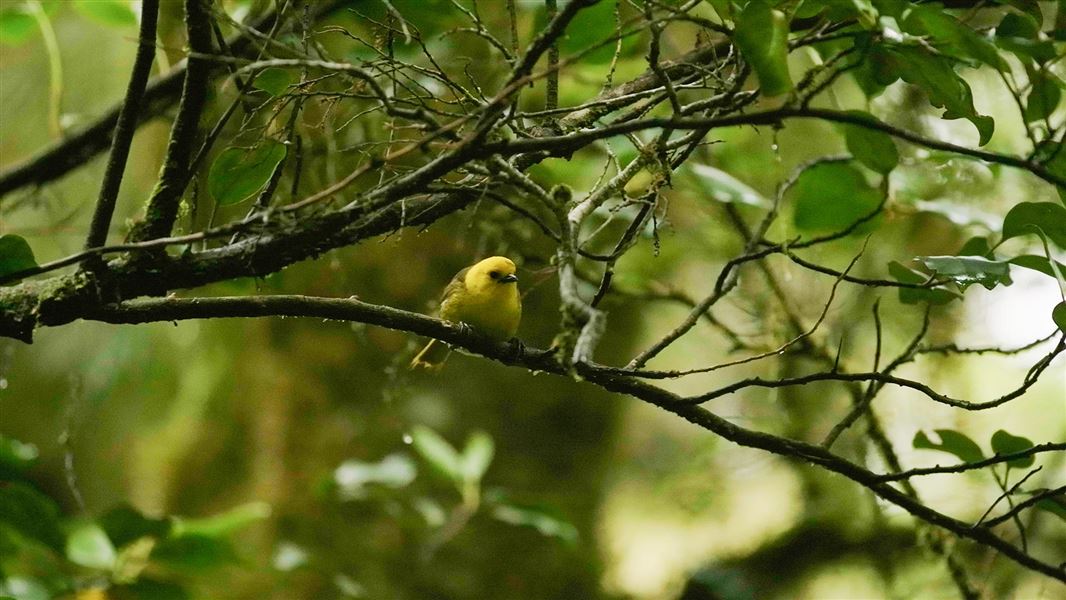Archived content: This media release was accurate on the date of publication.
Date: 08 April 2022
Recent counts of this Ngāi Tahu taonga species have reached 517 in the study area, up from a low of 14 birds since monitoring began 24 years ago. Mohua in the Landsborough valley may now number more than 2000 birds.
The bright yellow songbird was once predicted to disappear from the valley, as it has from most South Island forests, due to its sensitivity to introduced predators.
Results from the long-term monitoring show seven other native bird species continue to trend upwards, while six remain steady – overall a more than doubling of native birdlife. In contrast, introduced birds have declined, pushed out by their flourishing indigenous forest mates.
Department of Conservation (DOC) Principal Scientist Colin O’Donnell, who leads the research project, says sustained predator control since the mid-1990s is behind the swelling of the native bird community.
“It still surprises me each year when bird numbers keep going up because we don’t know what’s ‘normal’ or how far birds can recover in this environment.
“Mohua were once one of the most common forest birds in the South Island so their recovery in this valley gives us a hint of what forests may have sounded like before the arrival of exotic predators.
“The Landsborough success shows us what’s possible and what we can achieve by adapting this predator control recipe in other forests where mohua are in trouble.
“However, until we achieve a predator free Aotearoa, we need to sustain this recovery with trapping and the regular use of 1080 to keep rats, stoats and possums at low levels,” says Colin O’Donnell.
Apart from mohua, native birds on the increase include tuī, bellbird/korimako, brown creeper/pīpipi, rifleman/tītitipounamu, grey warbler/riroriro, fantail/pīwakawaka and yellow-crowned parakeet/kākāriki.
Counts for kākā, kea, tomtit/ngirungiru, wood pigeon/kererū, New Zealand falcon/kārearea and shining cuckoo/pīpīwharauroa have remained stable or are increasing at a very slow rate.
Two species, silvereye/tautou and long-tailed cuckoo/koekoeā, have declined. Greater competition for nectar from tuī and bellbird may have caused silvereye numbers to decrease. The long-tailed cuckoo migrates to the Pacific Islands each winter and may be being affected by conditions there.
Each year in late spring a team of three expert bird counters heads to the remote Landsborough valley and spends several days doing 5-minute bird counts at 175 stations evenly spaced in the beech forest. It’s DOC’s longest running bird monitoring project to measure the effects of predator control.
In the Landsborough, predators are kept low by traps along the valley floor and aerial 1080 when forest seeding causes rat numbers to increase (this has happened seven times since 1998). It’s a priority area for DOC’s predator control programme.
The aging trap network is being replaced with new traps assembled and laid by redeployed South Westland tourism workers funded through the Government’s Jobs for Nature initiative.
Background information
Mohua (population 5,000–20,000) have declined on the South Island mainland in the past five years and their threat status worsened in 2021, from ‘At-risk – recovering’ to ‘At-risk – declining’. They are doing well on pest-free islands and at some mainland sites such as the Landsborough and Hurunui South Branch (Canterbury) but have declined at sites like the Eglinton and Dart valleys where effective predator control remains a challenge.
The 50 km Landsborough River valley runs west of the Southern Alps/Kā Tiritiri o te Moana from south of Aoraki/Mt Cook to the Haast River. It is part of Te Wāhipounamu – South West New Zealand World Heritage Area.
Contact
For media enquiries contact:
Email: media@doc.govt.nz
